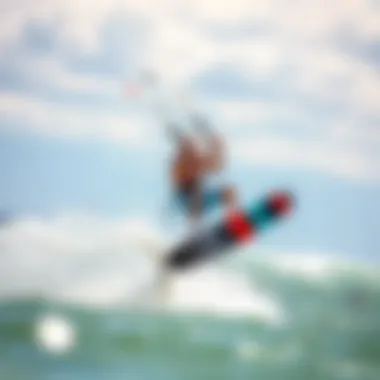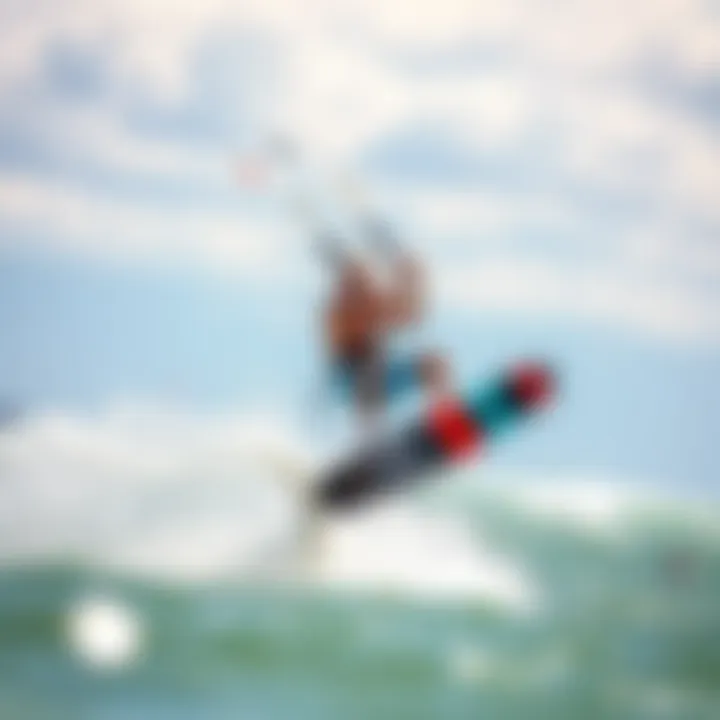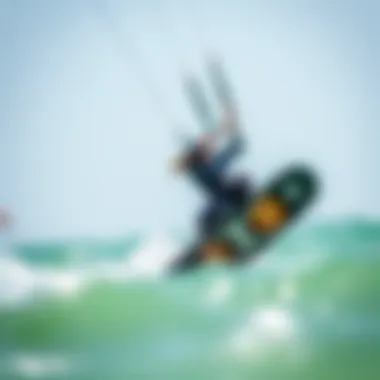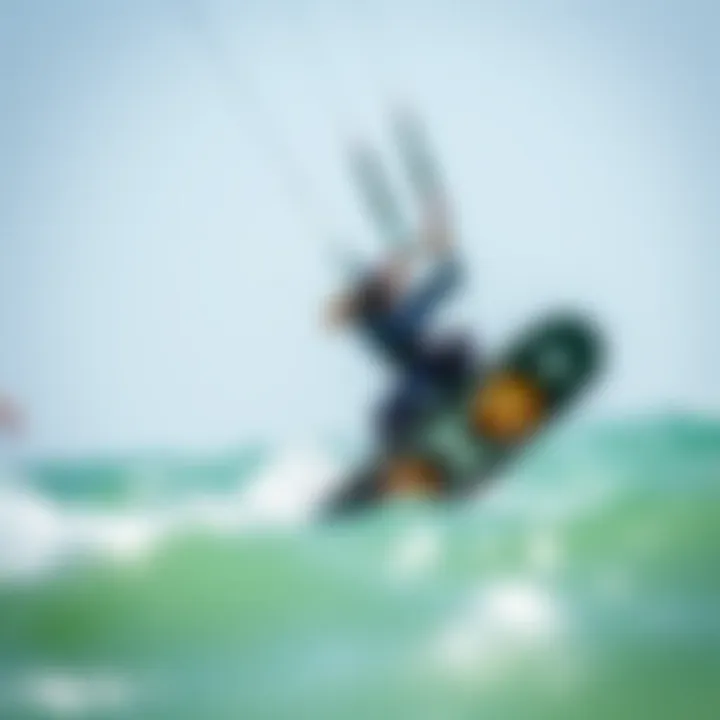Mastering the Hi Lo Pump in Kiteboarding


Intro
Kiteboarding, a thrilling sport that fuses the freedom of surfing with the exhilaration of flying, has its fair share of techniques that can greatly enhance performance. One such technique that has garnered attention among enthusiasts is the Hi Lo Pump. While it might sound simplistic, the way this technique is executed can dramatically influence a kiteboarder's experience, whether they're slicing through flat water or navigating choppy waves.
Imagine navigating your way across the water, harnessing the wind's power. The Hi Lo Pump is that subtle, rhythmic movement that not only keeps you moving but also allows for seamless transitions and speed adjustments. The essence of the Hi Lo Pump lies in its dynamic nature, enabling riders to maintain control while adapting to varying environmental conditions.
As this article unfolds, we'll dissect the mechanics of this technique, exploring what makes it so vital for achieving stability and efficiency on a kiteboard. From understanding the ideal gear to employing the right techniques, each component plays a crucial role in optimizing your ride. Whether you're just starting out or looking to refine your skills, there’s something in this guide for everyone passionate about kiteboarding.
Prolusion to the Hi Lo Pump
The Hi Lo Pump is more than just a technique; it's a gateway to better kiteboarding experiences. Understanding this method is vital for anyone looking to enhance their performance on the water. The Hi Lo Pump allows riders to effortlessly gain speed, maintain control, and adapt to varying conditions, making it a cornerstone of skilled kiteboarding.
Definition and Overview
At its core, the Hi Lo Pump is a rhythmic style of kiteboarding where riders use their body and kite movements in synchronization to generate speed and lift. Unlike conventional pumping techniques that might focus on brute effort, the Hi Lo Pump intertwines energy management with kite dynamics. This means that rather than exhausting oneself, a rider can create propulsion through careful positioning, timing, and subtle kite adjustments.
The method involves alternating between low and high positions, hence the name. When the body is low, it allows the kite to catch more wind. Conversely, raising the body triggers the kite to lift, providing necessary power surges. This intentional dance with the kite requires not just physical skill but also a keen understanding of the nuances in wind behavior and water conditions.
Historical Context in Kiteboarding
The evolution of the Hi Lo Pump is as fascinating as the technique itself. Initially, kiteboarding was heavily influenced by surf culture, where riders relied mostly on static power to move through the water. As the sport matured, riders began experimenting with various methods to maximize their efficiency and control.
In the late 90s and early 2000s, as kite technology advanced, the art of pumping took center stage. Riders noticed that specific body movements could significantly impact their speed and agility. Over time, what started as a simple adaptation transformed into a complex technique with its roots in balance and body mechanics. Pioneers of this method began sharing their insights through competitions and clinics, establishing the Hi Lo Pump as a crucial aspect of modern kiteboarding.
In summary, mastering the Hi Lo Pump is not just providing immediate benefits on the water but also connecting with the rich history of kiteboarding. Riders who embrace this technique not only improve their own skills but also contribute to the ongoing evolution of the sport.
Essential Mechanics of the Hi Lo Pump
The Hi Lo Pump is a pivotal technique within the kiteboarding realm that not only influences the individual rider's performance but also affects the overall dynamics of kite control. Understanding the essential mechanics of this technique can significantly enhance experiences on the water—whether you're carving clean turns or blazing ahead at exhilarating speeds.
Understanding Kite Dynamics
Kite dynamics is the foundation upon which the Hi Lo Pump rests. This encompasses how the kite interacts with the wind and how these interactions can be manipulated for optimal performance. A kiteboarder must comprehend several elements of kite dynamics:
- Lift and Drag: The kite generates lift when the wind strikes its surface, but this comes with drag—resistance that can slow a rider down. The trick is to find the sweet spot between these forces to maximize upward motion while minimizing slowing down.
- Angle of Attack: Adjusting the angle at which your kite meets the wind influences performance. A higher angle often yields more lift, but too high may lead to stalling. With the Hi Lo Pump, maintaining a manageable angle is crucial for consistent speed.
- Wind Variability: Not every kiteboarding session is blessed with steady breezes. Wind gusts can dramatically change the kite's behavior; hence, understanding how to adapt is vital. During the Hi Lo Pump, acknowledging changing wind conditions can keep the kite flying high instead of dropping low.
In summary, understanding kite dynamics isn't just about knowing how to fly the kite; it's about realizing how your input and external conditions work together.
Body Positioning and Movements
Next comes body positioning and movements, which play an instrumental role in the efficacy of the Hi Lo Pump. Proper posture can make a world of difference in generating and harnessing speed effectively:
- Center of Gravity: Keeping your center of gravity low helps with stability. Bending your knees and leaning slightly forward aligns your body in a way that boosts balance. Think of it like driving a car on a winding road—lowering your body’s center allows for smoother turns.
- Core Engagement: Engaging your core strengthens control over your movements. Without a strong core, it can become tricky to pivot or shift weight while pumping.
- Arm Positioning: Your hands should maintain a neutral grip on the bar. If your arms are flailing around, you’ll lose control quickly. Aim to have your arms relaxed yet ready to adjust the steering as needed. Your arms almost act like shock absorbers, adapting to the kite's movements while your body maintains control.
Effective body position aids in executing the Hi Lo Pump efficiently. It's not just about knowing the movements; performing them correctly can significantly elevate your kiteboarding skills.
Timing and Rhythm
The Hi Lo Pump operates not only on physical mechanics but also on timing and rhythm. Think of it as a dance between you and the kite, one that requires synchronization for a flawless performance:
- Creating a Pumping Rhythm: Establishing a rhythm helps to ensure that your movements with the kite and the board align perfectly. This synchronization dictates the effectiveness of the pumping motion. It's all about the ebb and flow—pumping the kite down to create pressure followed by a swift rise as the kite lifts.
- Wind Timing: Knowing when to initiate a pump, especially in relation to wind gusts, sets the stage for success. Not every gust is a friend. There will be times when a gust will threaten to pull you off balance, so timing your movements with the wind's intensity is crucial.
- Practice Makes Perfect: Timing won’t come overnight. Engaging in drills focused solely on pumping can improve one’s ability to read the wind and consequently adjust rhythm. Rinse and repeat; through deliberate practice, you will get into a groove that feels natural.
Overall, mastering timing and rhythm can elevate a kiter’s ability to harness the full benefits of the Hi Lo Pump, thus enhancing their overall experience on the water.
The Hi Lo Pump isn't just a technique; it's a language spoken between the rider and the wind, learning to listen and respond effectively makes all the difference in achieving mastery.
By gaining a thorough understanding of kite dynamics, optimizing body positioning, and honing timing and rhythm, kiteboarders can significantly enhance their Hi Lo Pump technique. Mastery in these areas creates the potential for more exhilarating rides, maximizing both speed and control.
Situational Applications of the Hi Lo Pump
The Hi Lo Pump's versatility makes it a crucial technique in kiteboarding. Different conditions demand varied approaches, and understanding how to adjust considerations can significantly impact performance. This section delves into how the Hi Lo Pump is executed across various wind conditions and water states, providing kiteboarders with insights to adapt their skills effectively.


Pumping in Different Wind Conditions
Pumping techniques must be tailored specifically to the wind conditions you face. Wind can be fickle, with light breezes demanding different tactics than strong gusts. Mastering these adjustments can make or break your session on the water.
Light Wind Conditions
Pumping in light wind presents a unique set of challenges. The key characteristic of this environment is the limited power that kites can generate. Kiteboarders often have to rely on consistent movement to maintain speed. This technique allows riders to harness what little energy is available, making it more than just a beneficial approach—it's essential.
In light winds, the unique feature is the need for a smooth and rhythmic pumping motion. Riders must stay light on their feet, always ready to readjust their body position. The advantage here is that it encourages riders to develop a finely tuned sense of balance and timing. However, this can come with disadvantages.
For instance, the less responsive nature of the kite in these winds might limit the options for tricks or sudden movements. Therefore, understanding how to optimize the Hi Lo Pump technique can better equip a rider to deal with these conditions.
Strong Wind Scenarios
On the flip side, strong wind scenarios pose their own challenges and rewards. The essential factor in this situation is the increased kite control and power available. Kiteboarding in high winds can yield exhilarating speed and impressive performance, yet it can also become overbearing for less-experienced riders.
The unique feature in these conditions is the aggressive pumping required to maintain stability and control. Riders must use calculated, powerful movements to keep the kite in the optimal position—this is where expert skills come into play. One of the advantages here is that the kite can generate enough lift to perform advanced maneuvers.
However, strong winds demand an awareness of equipment wear and tear, as well as fatigue. A mishandled kite in high gusts can lead to crashes or loss of control. Thus, a solid grasp of the Hi Lo Pump in strong winds is not just for performance; it's crucial for safety.
Techniques for Variable Water States
Equally important as wind conditions are the water states you may encounter when kiteboarding. Different types of water—be it choppy or flat—affect how you execute the Hi Lo Pump dramatically.
Choppy Water Management
Choppy water can be a kiteboarder’s nemesis, making the riding experience bumpy. The key facet here is learning how to adapt the Hi Lo Pump technique to maintain balance and speed on uneven surfaces. The way water behaves can make or break an overall ride.
Riding on choppy water requires quick adjustments and intense focus. The advantage lies in the necessity for adaptability—this situation fosters a rider’s agility and responsiveness. However, the disadvantage is the increased risk of losing control during harsher waves. To manage choppy water successfully, riders must adjust their body weight frequently and remain vigilant.
Flat Water Optimization
Conversely, flat water offers a smoother experience, which can highly benefit the Hi Lo Pump technique. The key characteristic of flat water is stability; it allows kiteboarders to focus more on their pumping rhythm without the interference of water turbulence.
The unique feature of this condition is the potential for higher speeds and easier performance of complex tricks. As a popular choice among enthusiasts, flat water promotes confidence in new riders, making it an optimal environment for skill development.
However, riders must remember that while flat conditions might seem more forgiving, they can lead to overconfidence and complacent technique. Thus, vigilance and a commitment to refining the Hi Lo Pump method are still critical.
The Hi Lo Pump is not just a technique; it's a way to elevate your kiteboarding game across any condition.
By thoroughly understanding the situational applications of the Hi Lo Pump, riders can significantly enhance their kiteboarding experience, adapting their methods to any setting they encounter.
Impact on Performance and Stability
Mastering the Hi Lo Pump can significantly influence a kiteboarder's performance and stability during their ride. The technique plays a crucial role in how riders interact with their kites, wind, and water conditions, making it an integral aspect of any kiteboarding session. Understanding its impact helps in maximizing efficiency while minimizing struggles with balance and fatigue. Here's a closer look at the key components affecting performance and stability through the Hi Lo Pump technique.
Enhancing Speed
Speed is often the name of the game in kiteboarding, and the Hi Lo Pump is your best ally in gaining that extra edge. By rhythmically shifting weight and strategically engaging the kite, riders can achieve notable acceleration without expending excessive energy.
- Continuous Motion: Regularly translating your body movements into the water while controlling the kite allows for a seamless increase in speed. It can feel as though you are "reading" the water, adjusting your weight as the conditions dictate.
- Kite Power Management: By effectively pumping the kite, riders can tap into gusts and gain speed that would otherwise be unavailable. When done correctly, it creates a continuous pull that enhances forward momentum and efficiency.
Improving Control and Balance
Control and balance are paramount in kiteboarding. The Hi Lo Pump maximizes both, allowing riders to maintain stability even in challenging conditions. This harmony between the kite and the rider is key to successful maneuvers.
- Centripetal Force: As you shift your weight, the dynamics of the kite shift, allowing for a controlled descent when needed. This shift helps in more quickly regaining stability after jumps or turns, reducing the chance of falling.
- Body Alignment: Maintaining a solid body position while applying the pump technique enhances control. It's like discovering the right balance beam in gymnastics. Proper alignment and technique ensure that you are not only balanced but also prepared to respond to sudden changes in wind or other environmental factors.
Minimizing Fatigue
Fatigue can quickly derail an otherwise enjoyable kiteboarding experience. Learning to optimize the Hi Lo Pump technique is a surefire way to conserve energy and extend your time on the water.
- Efficient Movement: Rather than overexerting every muscle, focus on fluid, efficient movements. This reduces the strain on your body while still allowing powerful propulsion forward.
- Mindful Techniques: Practices like steering with finesse rather than brute strength help lower overall fatigue. Learning to read the wind and adjust your technique accordingly can keep you riding longer without burning out.


"The Hi Lo Pump is not just about pulling harder; it’s about understanding the rhythm of your body and the kite. Harness that harmony, and you’ll find the ride of your life."
Overall, mastering the Hi Lo Pump technique leads to considerable improvements in your kiteboarding performance and stability. As riders become more attuned to the subtle feedback from their kites, they find themselves not just flying faster, but also enjoying the ride with greater ease and comfort. This not only enhances the experience but also builds confidence, allowing you to push boundaries during every session.
Common Mistakes and How to Avoid Them
Understanding the common pitfalls in implementing the Hi Lo Pump technique can dramatically influence a kiteboarding session. Recognizing what to avoid is key to mastering this essential skill. Many kiteboarders, particularly those who are just getting their feet wet with this technique, often find themselves dealing with frustrations that could be easily sidestepped. It’s about honing both skills and awareness, with the end goal of improving performance and enjoyment on the water.
Overexerting in Pumping
A frequent issue that arises among beginners is the tendency to overexert while pumping. The excitement to harness every gust of wind can lead to frantic movements, which actually undermines the efficiency of the Hi Lo Pump. Instead of picking up speed, this kind of energy can lead to misalignment and instability.
It’s vital to remember that pumping is about finding a rhythm rather than flailing around like a fish out of water. Effective pumping requires a blend of body movement and kite input that flows smoothly. Here are some considerations:
- Breath and Relax: Keeping a relaxed posture not only conserves energy but also enhances kite control.
- Focus on Timing: Work on synchronizing your body movements with the kite’s pull. This can yield a more fluid pumping motion.
- Practice Mindfulness: A few focused attempts rather than an all-out frenzy can be more beneficial.
Inconsistent Technique
Inconsistency is the enemy of progress. A kiteboarder may excel one day but struggle the next, primarily due to not sticking to a single approach. Changing techniques mid-session can leave one feeling disoriented, making it hard to measure what is truly working.
For creating a consistent technique, keep the following in mind:
- Develop a Routine: Establish a warm-up routine that includes practicing the Hi Lo Pump in a controlled setting. This builds familiarity and muscle memory.
- Commit to One Style: Figure out what works best for you. Once found, commit to that way of doing it to solidify it.
- Reflect and Adapt: Post-session reflection can help adjust minor flaws and foster consistency.
Neglecting Equipment Setup
Often, the simplest mistakes are the most detrimental. Neglecting proper equipment setup can lead to underwhelming performance when attempting the Hi Lo Pump. Each piece plays a pivotal role in executing techniques correctly. The following factors should be carefully examined:
- Kite Sizing and Type: Different conditions call for different kites. Make sure you choose a kite that matches the wind conditions.
- Harness and Line Configuration: Ensure that everything is locked in correctly; even a slight misalignment can result in a poor pumping experience.
- Board Choice: Not all boards are created equal. Selecting one that complements your pumping style and the water conditions is critical for optimizing performance.
Proper setup allows you to focus on your technique without the concerns of malfunctioning gear.
Avoiding these common mistakes is essential for kiteboarders who want to refine their Hi Lo Pump skills. Identifying weaknesses in your approach can lead to significant improvements over time. By maintaining awareness and commitment to better practices, every kiteboarder can enhance their overall experience on the water.
Equipment Considerations for Optimal Pumping
When it comes to maximizing performance in kiteboarding, the role of equipment cannot be overstated. The right gear can be the difference between a thrilling ride and a frustrating one, particularly when you're trying to execute the Hi Lo Pump technique effectively. Selecting the proper kite, ensuring a good harness fit, and opting for suitable board design all contribute significantly to the way you perform on the water. Let's dive deeper into each of these elements to understand their importance.
Kite Selection and Sizing
Choosing the right kite is foremost in any kiteboarder's mind. The size and type of kite should align with your riding style and the wind conditions you typically encounter. A larger kite might be ideal for light winds but can be cumbersome in stronger gusts. Conversely, a smaller kite can offer better handling in high winds but may leave you underpowered when the wind dies down.
- Type Matters: Different kites, such as C-kites or delta kites, offer distinct flight characteristics. Seasoned riders often have multiple kites to suit various conditions, which allows for effective pumping throughout varying environments.
- Sizing: As a rule of thumb, try to match the kite size to your weight and the winds you'll face. This tailored approach optimizes lift and control, making it easier to get the hang of Hi Lo Pump techniques.
Harness Fit and Functionality
Your harness is like the unsung hero of your kiteboarding experience. It's not just a piece of fabric; it connects you to the kite and must be comfortable to facilitate smooth movements. A proper fit can elevate your ability to pump seamlessly.
- Types of Harness: There are seat harnesses and waist harnesses, each suitable for specific riding styles. Seat harnesses might offer more support for beginners, whereas waist harnesses allow for more freedom of movement, which can be beneficial for advanced techniques like pumping.
- Customization: Make sure your harness is adjustable to accommodate your body shape. A snug fit ensures that energy transfer from your body to the kite remains efficient. Adjustments for straps and spreader bars can fine-tune your control during the pumping process.
Board Design and Performance Attributes
Not to be overlooked, the board you ride significantly contributes to your ability to execute the Hi Lo Pump. Different board designs cater to different styles of riding, and understanding these differences can give you an edge in your performance.
- Shape and Size: Boards come in various shapes and sizes, influencing speed, maneuverability, and stability. A wider board provides more surface area, which can be beneficial for beginners learning to pump. Meanwhile, a shorter, more streamlined board may offer improved speed for those who are already comfortable with their skills.
- Material Matters: The materials used in board construction can affect weight and durability. Lightweight boards can react faster to your movements, adding precision to your pumping. On the other hand, sturdier boards tend to withstand the rigors of rough conditions better.
Building Your Hi Lo Pump Skills
Building proficiency in the Hi Lo Pump technique is fundamental for kiteboarders who wish to elevate their riding experience and performance on the water. This technique underpins many aspects of kiteboarding, greatly affecting both speed and control. Mastering it means more than just learning a movement—it requires understanding the nuances of the sport and one’s own body dynamics.
A significant benefit of honing your Hi Lo Pump skills is the ability to seamlessly adapt to varying wind conditions. Whether you’re skimming over flat water or navigating choppy waves, effective pumping can be the difference between an exhilarating ride and a frustrating one. Furthermore, consistent practice leads to better muscle memory, allowing kiteboarders to instinctively respond to shifts in environmental conditions.
Structured Practice Routines


Developing a structured practice routine is akin to laying a solid foundation for a house. Just as the walls and roof will only be as strong as the base you build upon, the same is true for your kiteboarding skills. Routine practice should start simple, focusing on the basic motions of the Hi Lo Pump, and gradually building complexity as confidence and technique improve. Regular sessions—ideally, multiple times a week—allow for incremental progress without overwhelming the rider.
To maximize the effectiveness of training, vary the objectives of each session. Here are some tips on setting up a structured routine:
- Warm-up: Always begin with a proper warm-up to prevent injuries. Stretch your arms, legs, and back, paying special attention to your core.
- Focus on Fundamentals: Dedicate time to refining your body positioning and rhythm. These core components lay the groundwork for more advanced techniques.
- Use Drills: Implement drills that concentrate on different aspects of the Hi Lo Pump—from pumping in straight lines to adjusting to turns and jumps.
- Track Progress: Keep a journal of what you practiced and any observations about your technique. This can help you stay motivated and see growth over time.
Seeking Feedback and Coaching
Feedback can often be the golden key that unlocks further improvement; this is especially true in a sport as nuanced as kiteboarding. Seeking feedback from more experienced riders or instructors provides crucial insight that self-evaluation may miss. Often, the subtlety of small adjustments can dramatically affect performance.
Consider joining kiteboarding communities or clubs. Engaging with peers not only fosters a supportive environment but opens avenues for valuable critiques. Additionally, professional coaching can fast-track your learning process. Look for instructors who specialize in the Hi Lo Pump or whose riding style resonates with you. They can offer personalized guidance tailored to your weaknesses and strengths.
Video Analysis for Progress
In the age of technology, video analysis has become a powerful tool for athletes across various sports, including kiteboarding. Recording yourself while practicing the Hi Lo Pump allows for self-review, helping you identify areas of improvement that may not be immediately obvious in real-time.
When setting up video analysis, follow these steps:
- Choose an Optimal Angle: Position your camera where it can capture your entire body movements, ideally from the side and slightly above. This will help you understand your body mechanics better.
- Record Multiple Takes: Don’t hesitate to take several recordings during a session. Different perspectives can reveal varying aspects of your pumping technique.
- Review and Reflect: Set aside time post-session to review the recordings. Take notes on technique, noting inconsistencies in body position, timing, or rhythm that you might want to address.
- Share for Feedback: If you're part of a community or have a coach, share your videos with them to gain more insights into your practice.
Getting good at the Hi Lo Pump is about developing a deeper connection with your riding. The journey is not just about mastering the technique; it’s about enjoying the evolution of your skills, which can lead to a more fulfilling experience on the water.
Expert Insights and Tips from Professionals
In the realm of kiteboarding, the Hi Lo Pump technique is not just a skill; it’s a lifeline for enhancing performance. Gaining insights from seasoned riders and competitive kiteboarders provides a well-rounded understanding of how to effectively implement this technique. Their experiences, accumulated over countless hours on the water, offer invaluable perspectives that can catalyze improvement for both novices and those looking to refine their approach.
Interviews with Experienced Riders
The wisdom shared by experienced riders can often be the compass for many kiteboarders. When we sit down with these veterans, their stories can illuminate the path of mastery in the Hi Lo Pump. One such rider, Chloe, a pro kiteboarder, emphasizes the mental aspect of pumping. "It’s about feeling the kite. You have to be in tune with what it’s doing. Each gust is an invitation to adjust your body position, shift your weight, and get that perfect rhythm."
This perspective highlights that it’s not merely about the mechanics, but also about a deeper connection with the kite. Furthermore, Tom, who has been riding for over a decade, shared how adaptability in varying conditions is key. "When the wind is light, it’s all about finesse. Conversely, in strong winds, it takes a different form of aggression and power. You must adapt your style accordingly."
These insights bring to light the importance of developing an intuitive feel for conditions and the kite itself in order to effectively harness the Hi Lo Pump technique.
Best Practices from Competitive Kiteboarders
When it comes to competitive kiteboarding, the stakes are high, and every detail matters. Those who compete often distill their practices into a set of best practices that can serve as a blueprint for all kiteboarders.
- Focus on Body Mechanics: Proper body positioning is paramount. Top riders like Sarah stress the importance of maintaining a low center of gravity during pumping. This helps in stabilizing the kite and maintaining speed.
- Controlled Breathing: Keeping calm is crucial. Many competitive riders use breathing techniques to control their excitement and maintain focus, allowing them to respond better to the kite's movements.
- Condition Adaptation: The ability to read the water and wind conditions faster than opponents can be a game-changer. Competitive kiteboarders often practice in various conditions to fine-tune their pumping techniques.
- Incorporate Drills: Regular practice sessions with structured drills designed to enhance pumping efficiency are common. Riders allocate specific time during their sessions to focus purely on this aspect, which helps in building muscle memory.
- Peer Review: Engaging in mutual feedback sessions with fellow kiteboarders can reveal blind spots in one’s technique. Observing and being observed can foster improvement within the riding community.
The experiences shared by professionals remind us that growth in kiteboarding often stems from personal reflection and a willingness to learn from every ride.
Incorporating these practices can not only elevate one’s performance but also instill a level of confidence necessary for more advanced maneuvers and conditions. For any kiteboarder eager to enhance their mastery of the Hi Lo Pump, leaning into the wisdom of those who have navigated this learning curve can prove immensely beneficial.
Closure: The Importance of Mastering the Hi Lo Pump
Mastering the Hi Lo Pump technique is vital for any kiteboarder. This technique not only enhances performance but also directly influences the overall riding experience. Getting the fundamentals right—understanding how to pump correctly—can elevate one’s skills to new heights.
One key aspect to consider is speed management. The Hi Lo Pump allows riders to harness wind energy more effectively, making it easier to navigate through various wind conditions. In strong winds, a well-executed pump can help maintain velocity while enhancing control. Conversely, in lighter winds, it enables the rider to optimize their kite’s lift, helping to avoid stalling.
Additionally, the technique plays a critical role in stability and balance. When practiced regularly, it becomes second nature, leading to smoother rides with less fatigue. Riders who are proficient in this technique report feeling more connected to their kite and water, which can lead to more confident maneuvers and higher jumps.
"The Hi Lo Pump allows for seamless transition between different speeds and wind conditions, fundamentally changing the kiteboarding experience."
Another element to ponder is the social aspect of the sport. As kiteboarding continues to grow, sharing techniques with fellow enthusiasts creates a supportive learning environment. Riding with someone who’s well-versed in the Hi Lo Pump can provide valuable insights and tips that aren't found in textbooks or tutorials. It cultivates a community geared toward mutual growth, allowing all participants to improve faster.
Lastly, mastering the Hi Lo Pump contributes to the long-term passion for kiteboarding. As riders succeed in refining their technique and conquering new challenges, they create a deeper connection to the sport. Each new achievement can spark the desire to explore and master further techniques or even progress into competitive kiteboarding.
Summary of Key Takeaways
- Speed Management: The Hi Lo Pump helps in controlling speed across varying wind conditions.
- Enhanced Stability: Mastering this technique leads to greater control and reduces fatigue.
- Community Engagement: Practicing with others fosters learning and community support.
- Personal Growth: Excelling in this technique deepens the connection to kiteboarding, encouraging further exploration.
Encouragement for Continuous Improvement
Continuous improvement in the Hi Lo Pump is essential for all kiteboarders wanting to elevate their game. Regular practice will not only solidify your skills but also instill confidence on the water.
Participate in kiteboarding forums or join local clubs to engage with experienced riders who can offer feedback and new tips. Use video analysis to assess your pumping technique; seeing yourself can reveal patterns you may want to adjust.
Don’t shy away from challenges—seek out diverse waters and wind conditions to test your skills under pressure. The more you push your limits, the more proficient you will become. Above all, enjoy the process! Kiteboarding is as much about the journey as it is about the destination. Every improvement in the Hi Lo Pump will contribute to a rewarding and exhilarating ride.















